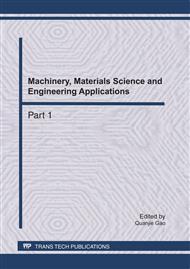p.433
p.439
p.447
p.453
p.458
p.464
p.471
p.477
p.484
Study on the Critical Cutting Thickness and the Precision Cutting Experiments of Isotropic Pyrolyric Graphite
Abstract:
Isotropic pyrolyric graphite (IPG) is a new kind of brittle material, it not only has the general advantages of ordinal carbonaceous materials such as high temperature resistance, lubrication and abrasion resistance, but also has the advantages of impermeability and machinability that carbon/carbon composite doesn’t have. So it can be used for sealing the aeronautics and astronautics engines turbine shaft and the ethylene high-temperature equipment. The mechanism of this material removal during the precision cutting was analyzed by using the theory of strain gradient. The critical cutting thickness of IPG was calculated for the first time. Furthermore, the cutting process parameters such as cutting depth and feed rate which corresponding to the scale of brittle-ductile transition deformation of IPG was calculated. The prediction model of surface roughness in precision cutting of IPG was developed based on the Genetic algorithm. Using the surface roughness prediction model, the study investigates the influence of the cutting speed, the feed rate and the cutting depth on surface roughness in precision turning process was researched.
Info:
Periodical:
Pages:
458-463
Citation:
Online since:
April 2011
Authors:
Price:
Сopyright:
© 2011 Trans Tech Publications Ltd. All Rights Reserved
Share:
Citation:


